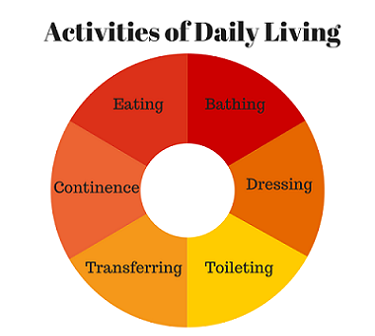ADLs (activities of daily living): The things we normally do in daily living including any daily activity we perform for self-care such as feeding ourselves, bathing, dressing, grooming, work, homemaking, and leisure. The ability or inability to perform ADLs can be used as a very practical measure of ability/disability in many disorders.
What are the Activities of Daily Living (ADLs)?
There are many variations on the definition of the activities of daily living but most organizations agree there are 5 basic categories.
- Personal hygiene – bathing, grooming and oral care
- Dressing – the ability to make appropriate clothing decisions and physically dress oneself
- Eating – the ability to feed oneself though not necessarily to prepare food
- Maintaining continence – both the mental and physical ability to use a restroom
- Transferring – moving oneself from seated to standing and get in and out of bed
What are the Instrumental Activities of Daily Living (IADLs)?
IADLs are actions that are important to being able to live independently but are not necessarily required activities on a daily basis. The instrumental activities are more subtle than the Activities of Daily Living. They can help determine with greater detail the level of assistance required by an elderly or disabled person. The IADLs include:
- Basic communication skills – such as using a regular phone, mobile phone, email or the Internet
- Transportation – either by driving oneself, arranging rides or the ability to use public transportation
- Meal preparation – meal planning, preparation, storage and the ability to safely use kitchen equipment
- Shopping – the ability to make appropriate food and clothing purchase decisions
- Housework – doing laundry, cleaning dishes and maintaining a hygienic place of residence
- Managing medications – taking accurate dosages at the appropriate times, managing re-fills and avoiding conflicts
- Managing personal finances – operating within a budget, writing checks, paying bills and avoiding scams
Reasons for Assessments
Due to birth defects, accidents, disease, or simply aging, people may lose these self-care skills to varying degrees. In older populations, changes in behavior may indicate loss of ADLs. Perhaps bills are going unpaid, the house is not as tidy as usual, medications are not taken, or the refrigerator contains only a few foods and they may be obviously past their prime. Maybe the individual is getting lost in familiar places or having car accidents, his clothes appear dirty, or there is some unpleasant body odor. People who are losing their BADLs may have difficulty walking or experience frequent falls.
When these concerns are brought to the attention of a physician, the health care team will do a functional assessment to document the areas of concern. This assessment helps them identify possible root problems, like dementia, an acute physical condition, or the worsening of a chronic disease, and determine what diagnostic studies are needed to figure out why the person is having these problems, especially if they are new problems. The functional assessment also helps clarify for the family the specific kinds of help their loved one needs in order to live as independently as possible.
ADLs / IADLs
- Bathing
- Dressing
- Grooming
- Oral Care
- Toileting
- Transferring
- Walking
- Climbing Stairs
- Eating
- Shopping
- Cooking
- Managing Medications
- Uses the Phone
- Housework
- Laundry
- Driving
- Managing Finances
- Passive Supervision (to prevent wandering or self-injury)
Benefits of daily active living:
- Reduce stress
- Improve mood & self-esteem
- Increase energy
- Improve concentration
- Improve sleep quality
- Reduce risk of chronic illness
Source:


